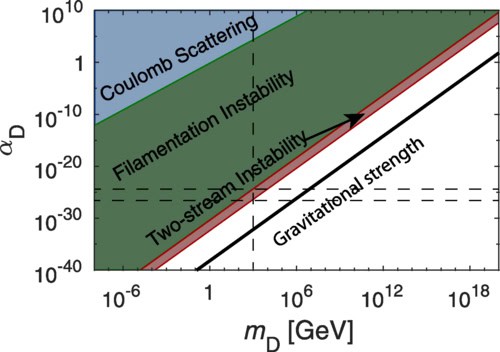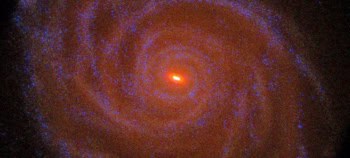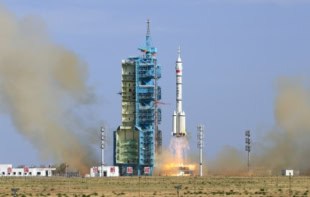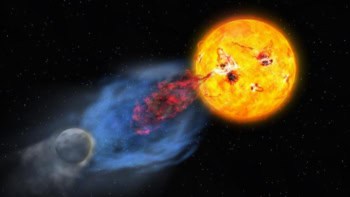
Physicists have set a new upper bound on the interaction strength of dark matter by simulating the collision of two clouds of interstellar plasma. The result, from researchers at Ruhr University Bochum in Germany, CINECA in Italy and the Instituto Superior Tecnico in Portugal, could force a rethink on theories describing this mysterious substance, which is thought to make up more than 85% of the mass in the universe.
Since dark matter has only ever been observed through its effect on gravity, we know very little about what it’s made of. Indeed, various theories predict that dark matter particles could have masses ranging from around 10−22 eV to around 1019 GeV — a staggering 50 orders of magnitude.
Another major unknown about dark matter is whether it interacts via forces other than gravity, either with itself or with other particles. Some physicists have hypothesized that dark matter particles might possess positive and negative “dark charges” that interact with each other via “dark electromagnetic forces”. According to this supposition, dark matter could behave like a cold plasma of self-interacting particles.
Bullet Cluster experiment
In the new study, the team searched for evidence of dark interactions in a cluster of galaxies located several billion light years from Earth. This galactic grouping is known as the Bullet Cluster, and it contains a subcluster that is moving away from the main body after passing through it at high speed.
Since the most basic model of dark-matter interactions relies on the same equations as ordinary electromagnetism, the researchers chose to simulate these interactions in the Bullet Cluster system using the same computational tools they would use to describe electromagnetic interactions in a standard plasma. They then compared their results with real observations of the Bullet Cluster galaxy.

The new work builds on a previous study in which members of the same team simulated the collision of two clouds of standard plasma passing through one another. This study found that as the clouds merged, electromagnetic instabilities developed. These instabilities had the effect of redistributing energy from the opposing flows of the clouds, slowing them down while also broadening the temperature range within them.
Ruling out many of the simplest dark matter theories
The latest study showed that, as expected, the plasma components of the subcluster and main body slowed down thanks to ordinary electromagnetic interactions. That, however, appeared to be all that happened, as the data contained no sign of additional dark interactions. While the team’s finding doesn’t rule out dark electromagnetic interactions entirely, team member Kevin Schoeffler explains that it does mean that these interactions, which are characterized by a parameter known as 𝛼𝐷, must be far weaker than their ordinary-matter counterpart. “We can thus calculate an upper limit for the strength of this interaction,” he says.
This limit, which the team calculated as 𝛼𝐷 < 4 x 10-25 for a dark matter particle with a mass of 1 TeV, rules out many of the simplest dark matter theories and will require them to be rethought, Schoeffler says. “The calculations were made possible thanks to detailed discussions with scientists working outside of our speciality of physics, namely plasma physicists,” he tells Physics World. “Throughout this work, we had to overcome the challenge of connecting with very different fields and interacting with communities that speak an entirely different language to ours.”

Delayed Big Bang for dark matter could be detected in gravitational waves
As for future work, the physicists plan to compare the results of their simulations with other astronomical observations, with the aim of constraining the upper limit of the dark electromagnetic interaction even further. More advanced calculations, such as those that include finer details of the cloud models, would also help refine the limit. “These more realistic setups would include other plasma-like electromagnetic scenarios and ‘slowdown’ mechanisms, leading to potentially stronger limits,” Schoeffler says.
The present study is detailed in Physical Review D.



